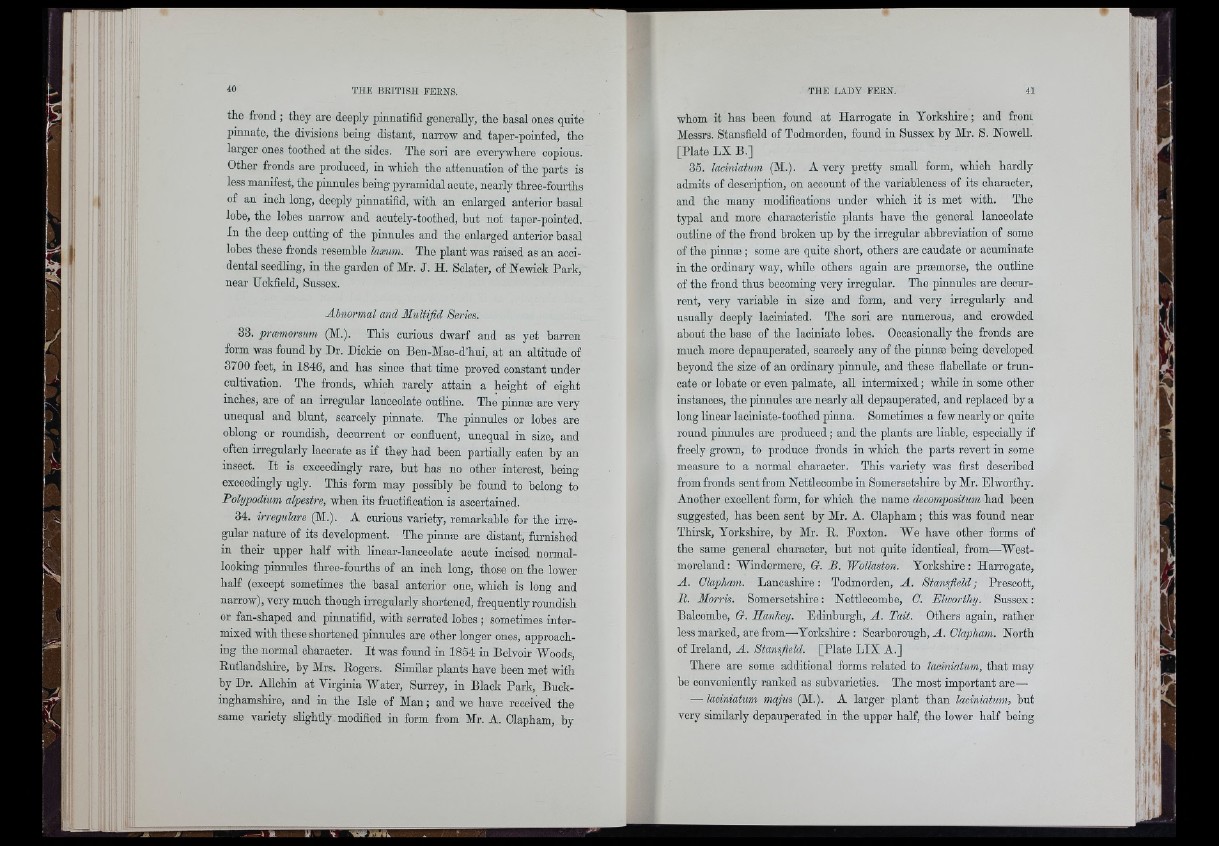
the frond ; they are deeply pinnatifid generally, the basal ones quite
pinnate, tbe divisions being distant, narrow and taper-pointed, the
larger ones toothed at the sides. The sori are everywhere copious.
Other fronds are produced, in which the attenuation of the parts is
less manifest, the pinnules being pyramidal acute, nearly three-fourths
of an inch long, deeply pinnatifid, with an enlarged anterior basal
lobe, the lobes narrow and acutely-tootbed, but not taper-pointed.
In the deep cutting of the pinnules and the enlarged anterior basal
lobes these fronds resemble laxum. The plant was raised as an accidental
seedling, in the garden of Mr. J. H. Sclater, of Newick Park,
near Uckfield, Sussex.
Abnormal and Multi fid Series.
33. præmorsum (M.). This curious dwarf and as yet barren
form was found by Dr. Dickie on Ben-Mac-d’hui, at an altitude of
3700 feet, in 1846, and has since that time proved constant under
cultivation. The fronds, which rarely attain a height of eight
inches, are of an irregular lanceolate outline. The pinnæ are very
unequal and blunt, scarcely pinnate. The pinnules or lobes are
oblong or roundish, deourrent or confluent, unequal in size, and
often irregularly lacerate as if they had been partially eaten by an
insect. It is exceedingly rare, but has no other interest, being
exceedingly ugly. This form may possibly be found to belong to
Polypodium alpestre, when its fructification is ascertained.
34. irreguläre (M.). A curious variety, remarkable for the irregular
nature of its development. The pinnæ are distant, furnished
in their upper half with Unear-lanceolate acute incised normal-
looking pinnules three-fourths of an inch long, those on the lower
half (except sometimes the basal anterior one, which is long and
narrow), very much though irregularly shortened, frequently roundish
or fan-shaped and pinnatifid, with serrated lobes ; sometimes intermixed
with these shortened pinnules are other longer ones, approaching
the normal character. It was found in 1854 in Belvoir Woods,
Eutlandshire, by Mrs. Eogers. Similar plants have been met with
by Dr. AUchin at Virginia Water, Surrey, in Black Park, Buckinghamshire,
and in the Isle of Man ; and we have received the
same variety slightly modified in form from Mr. A. Clapham, by
whom it has been found at Harrogate in Yorkshire; and from
Messrs. Stansfleld of Todmorden, found in Sussex by Mr. S. Nowell.
[Plate LX B.]
35. laciniatum (M.). A very pretty small form, which hardly
admits of description, on account of the variableness of its character,
and the many modifications under which it is met with. The
typal and more characteristic plants have the general lanceolate
outline of the frond broken up by the irregular abbreviation of some
of the pinnæ ; some are quite short, others are caudate or acuminate
in the ordinary way, while others again are præmorse, the outline
of the frond thus becoming very irregular. The pinnules are decur-
ront, very variable in size and form, and very irregularly and
usually deeply laoiniated. The sori are numerous, and crowded
about the base of the laoiniate lobes. Occasionally the fronds are
much more depauperated, scarcely any of the pinnæ being developed
beyond the size of an ordinary pinnule, and these flabeUate or truncate
or lohate or even palmate, all intermixed ; while in some other
instances, the pinnules are nearly all depauperated, and replaced by a
long linear laoiniate-toothed pinna. Sometimes a few nearly or quite
round pinnules are produced ; and the plants are Kable, especially if
freely grown, to produce fronds in which the parts revert in some
measure to a normal character. This variety was first described
from fronds sent from Nettlecombe in Somersetshire by Mr. Elworthy.
Another excellent form, for which the name deeompositmn had been
suggested, has been sent by Mr. A. Clapham ; this was found near
Thirsk, Yorkshire, by Mr. E. Foxton. We have other forms of
the same general character, hut not quite identical, from—^Westmoreland
: Windermere, (?. B. Wollaston. Yorkshire ; Harrogate,
A. Clapham. Lancashire: Todmorden, A. Stansfleld; Prescott,
B. Morris. Somersetshire : Nettlecombe, C. Elworthy. Sussex :
Baloombe, G. Hankey. Edinburgh, A. Tait. Others again, rather
less marked, are from—-Yorkshire: Scarborough, ri. CTop/iam. North
of Ireland, A. Stansfleld. [Plate LIX A.]
There are some additional forms related to laciniatum, that may
he conveniently ranked as subvarieties. The most important are—
— laciniatum majus (M.). A larger plant than laciniatum, but
very similarly depauperated in the upper half, the lower half being
s. 1
!
I >1
(
If
' j ■
I r